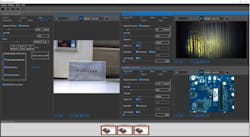Specializing in machine visioncameras for industrial, medical, scientific, and microscopy applications, Pixelinkis a company that sets out to stay out ahead of the curve and develop products that provide full solutions instead of just components.
"Customers will come to us and want us to tell them what to use," Paul Saunders, President, said recently when I visited the company’s Ottawa, ON, Canada office. "This is working very well for us right now because we have a knowledgeable sales team and incredibly talented engineers."
He continued, "The mindset ultimately must be ‘vision applications,’ so we focus on "how do our customers build these applications" and what can we build to help them get to market faster. When vision systems are built for companies, they are trying to reduce risk and get projects out to market quicker. For the OEM world, this is very important. It is a very competitive world for all manufacturers."
Pixelink was acquired by lens company Navitar in January of 2017. Part of the reasoning behind this, explained both Saunders and Lars Nielsen, Marketing Manager, was because of Pixelink’s expertise with integrating autofocus and liquid lens technology into cameras.
"Autofocus and liquid lens technology is integrated into the cameras, so the lens is being focused by the camera" said Nielsen. "This provides an integrated optics solution and one of the reasons Navitar was interested in acquiring Pixelink."
In terms of what is new with the company, Pixelink Capture, the company’s real-time, multi-camera image capture software, offers a number of new capabilities and features, the most prominent of which is a metrology tool. With the new metrology feature, users can measure something, set a distance with a line in the software, and then measure items in real-life coordinates, according to Saunders.
"You can also measure points, circles, radius, rectangle, polyline (series of lines connected end-to-end). Polygon can also calculate area in the field of view as well. Color lines can be changed to work within the image as well. The export to Excel option allows an easy download of all measurements in addition to a screenshot of all of the measurements and relevant information for each measurement," explained Saunders.
"Metrology functionalities," he added, "are being built into cameras, but what we are doing is driving more value into the software and allowing people to develop applications much easier."
The new tool gives users numerous metrology functions, allowing them to develop their applications, providing more of a "bundle" and removing some of the coding work that would otherwise be involved. In addition to this, lens control will also be available within the software soon, noted Nielsen.
"We are quite excited about the software we are developing, which will enable us to build an integrated solution of cameras and optics under one roof to ‘present the customer with the best out of box experience.’ We will deliver camera, cable, software, optics and even alignthe sensor and lens and set it up for people," he said.
Looking toward the future at possible growth areas, Nielsen and Saunders discussed some projects involving agricultural inspection, virtual and augmented reality, and live holography, they are working on. Unfortunately, for us anyway, these projects were under non-disclosure agreements, so I can only discuss the topics and not the details here.
Bandwidth, suggested Saunders, is also something that is very important going forward.
"We made a bet on USB3 and we are making a bet on USB 3.1 (going from 5 to 10 Gb bandwidth). The connector will be 24 pins, so the data transfer will be better, plus you are going from about 7 (at least in the initial spec) to 100 W for power as well. More power, more bandwidth, more cameras. This ties into our interest in multi-camera applications. Bandwidth will also be filled, so the more the bandwidth, the better," he said.
View more information on Pixelink.
Share your vision-related news by contacting James Carroll, Senior Web Editor, Vision Systems Design
To receive news like this in your inbox, click here.
Join our LinkedIn group | Like us on Facebook | Follow us on Twitter






